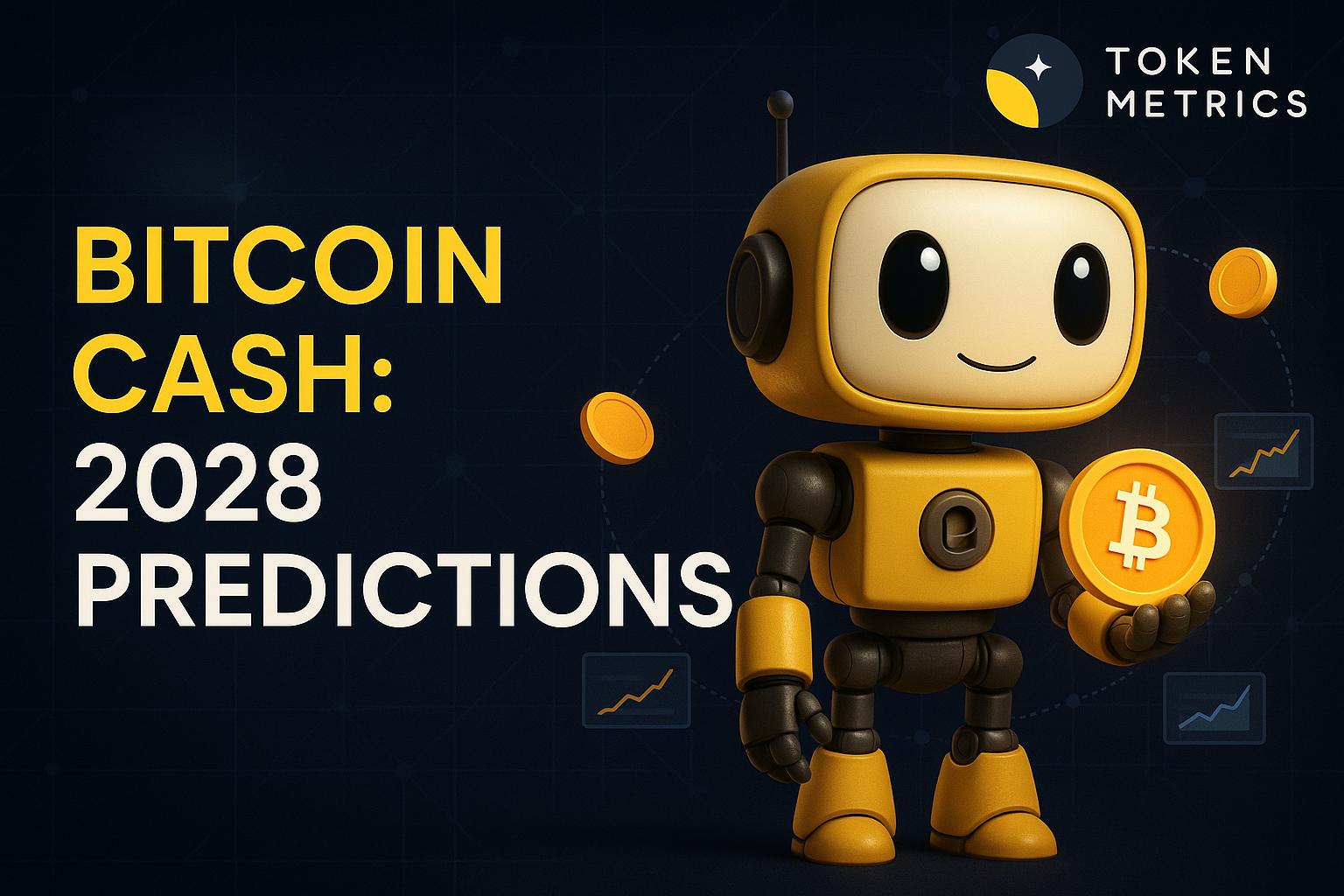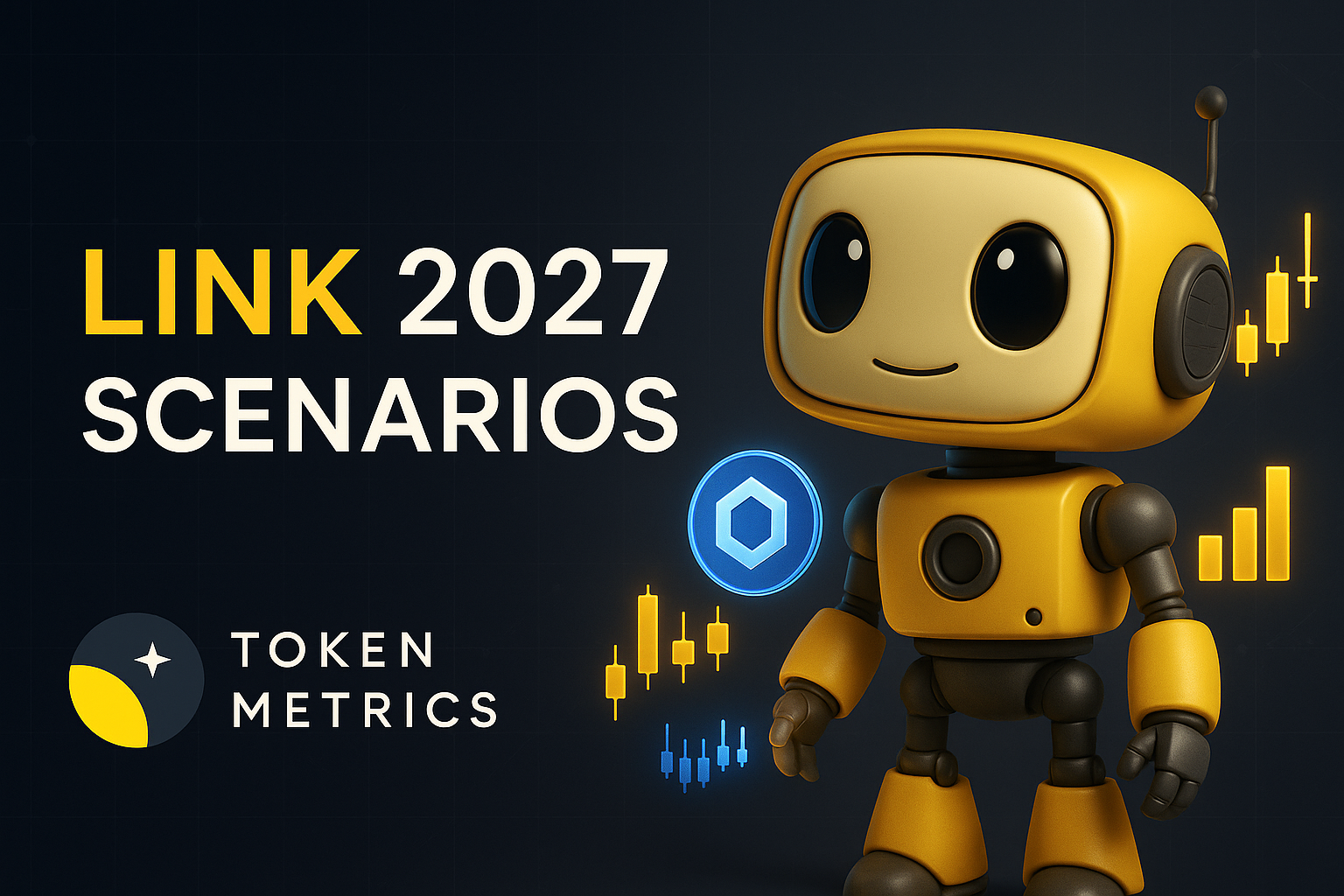Top Crypto Trading Platforms in 2025







%201.svg)
%201.svg)
Big news: We’re cranking up the heat on AI-driven crypto analytics with the launch of the Token Metrics API and our official SDK (Software Development Kit). This isn’t just an upgrade – it's a quantum leap, giving traders, hedge funds, developers, and institutions direct access to cutting-edge market intelligence, trading signals, and predictive analytics.
Crypto markets move fast, and having real-time, AI-powered insights can be the difference between catching the next big trend or getting left behind. Until now, traders and quants have been wrestling with scattered data, delayed reporting, and a lack of truly predictive analytics. Not anymore.
The Token Metrics API delivers 32+ high-performance endpoints packed with powerful AI-driven insights right into your lap, including:
Getting started with the Token Metrics API is simple:
At Token Metrics, we believe data should be decentralized, predictive, and actionable.
The Token Metrics API & SDK bring next-gen AI-powered crypto intelligence to anyone looking to trade smarter, build better, and stay ahead of the curve. With our official SDK, developers can plug these insights into their own trading bots, dashboards, and research tools – no need to reinvent the wheel.
%201.svg)
%201.svg)
The Layer 1 landscape is consolidating as users and developers gravitate to chains with clear specialization. Bitcoin Cash positions itself as a payment-focused chain with low fees and quick settlement for everyday usage.
The scenario projections below map potential outcomes for BCH across different total crypto market sizes. Base cases assume steady usage and listings, while moon scenarios factor in stronger liquidity and accelerated adoption.
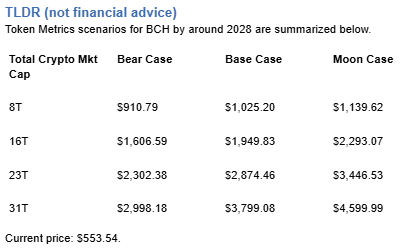
Disclosure
Educational purposes only, not financial advice. Crypto is volatile, do your own research and manage risk.
How to read it: Each band blends cycle analogues and market-cap share math with TA guardrails. Base assumes steady adoption and neutral or positive macro. Moon layers in a liquidity boom. Bear assumes muted flows and tighter liquidity.
TM Agent baseline:
Token Metrics lead metric for Bitcoin Cash, cashtag $BCH, is a TM Grade of 54.81%, which translates to Neutral, and the trading signal is bearish, indicating short-term downward momentum. This implies Token Metrics views $BCH as mixed value long term: fundamentals look strong, while valuation and technology scores are weak, so upside depends on improvements in adoption or technical development. Market context: Bitcoin has been setting market direction, and with broader risk-off moves altcoins face pressure, which increases downside risk for $BCH in the near term.
Live details:
Affiliate Disclosure: We may earn a commission from qualifying purchases made via this link, at no extra cost to you.
Token Metrics scenarios span four market cap tiers, each representing different levels of crypto market maturity and liquidity:
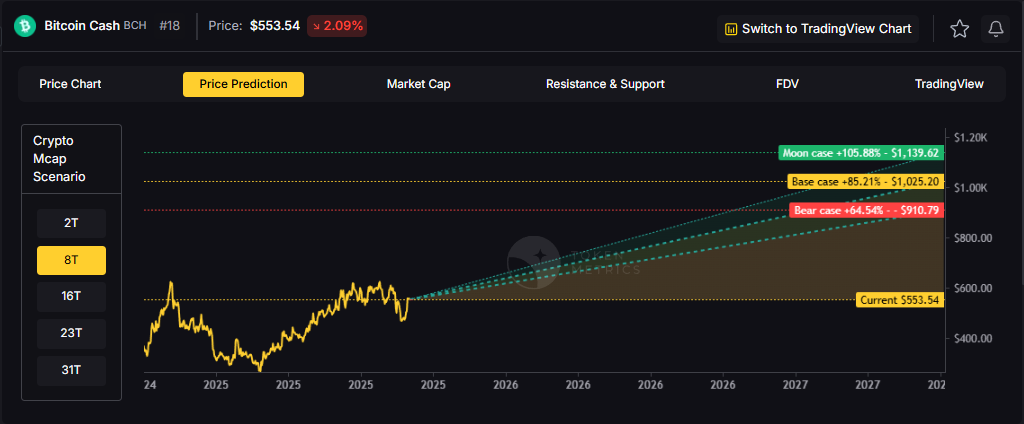


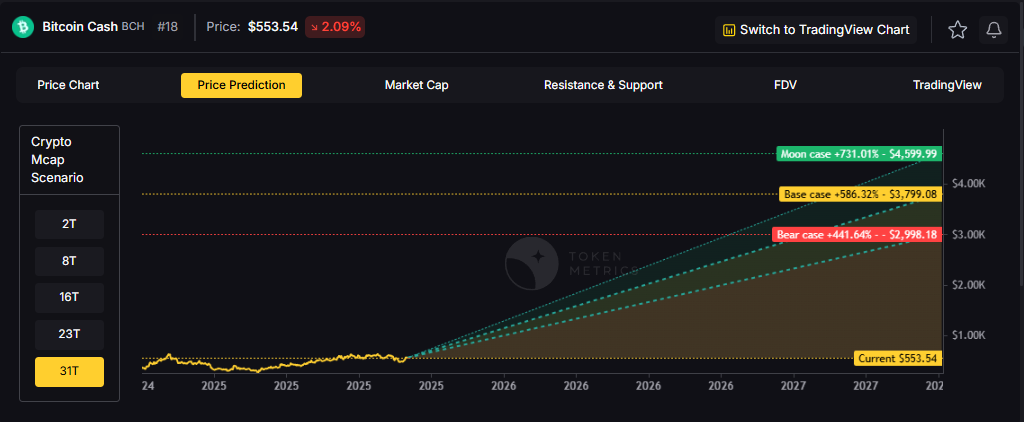
Each tier assumes progressively stronger market conditions, with the base case reflecting steady growth and the moon case requiring sustained bull market dynamics.
Bitcoin Cash represents one opportunity among hundreds in crypto markets. Token Metrics Indices bundle BCH with top one hundred assets for systematic exposure to the strongest projects. Single tokens face idiosyncratic risks that diversified baskets mitigate.
Historical index performance demonstrates the value of systematic diversification versus concentrated positions.
Bitcoin Cash is a peer-to-peer electronic cash network focused on fast confirmation and low fees. It launched in 2017 as a hard fork of Bitcoin with larger block capacity to prioritize payments. The chain secures value transfers using proof of work and aims to keep everyday transactions affordable.
BCH is used to pay transaction fees and settle transfers, and it is widely listed across major exchanges. Adoption centers on payments, micropayments, and remittances where low fees matter. It competes as a payment‑focused Layer 1 within the broader crypto market.
Token Metrics AI provides comprehensive context on Bitcoin Cash's positioning and challenges.
Vision:
Bitcoin Cash (BCH) is a cryptocurrency that emerged from a 2017 hard fork of Bitcoin, aiming to function as a peer-to-peer electronic cash system with faster transactions and lower fees. It is known for prioritizing on-chain scalability by increasing block sizes, allowing more transactions per block compared to Bitcoin. This design choice supports its use in everyday payments, appealing to users seeking a digital cash alternative. Adoption has been driven by its utility in micropayments and remittances, particularly in regions with limited banking infrastructure. However, Bitcoin Cash faces challenges including lower network security due to reduced mining hash rate compared to Bitcoin, and ongoing competition from both Bitcoin and other scalable blockchains. Its value proposition centers on accessibility and transaction efficiency, but it operates in a crowded space with evolving technological and regulatory risks.
Problem:
The project addresses scalability limitations in Bitcoin, where rising transaction fees and slow confirmation times hinder its use for small, frequent payments. As Bitcoin evolved into a store of value, a gap emerged for a blockchain-based currency optimized for fast, low-cost transactions accessible to the general public.
Solution:
Bitcoin Cash increases block size limits from 1 MB to 32 MB, enabling more transactions per block and reducing congestion. This on-chain scaling approach allows for faster confirmations and lower fees, making microtransactions feasible. The network supports basic smart contract functionality and replay protection, maintaining compatibility with Bitcoin's core architecture while prioritizing payment utility.
Market Analysis:
Bitcoin Cash operates in the digital currency segment, competing with Bitcoin, Litecoin, and stablecoins for use in payments and remittances. While not the market leader, it occupies a niche focused on on-chain scalability for transactional use. Its adoption is influenced by merchant acceptance, exchange liquidity, and narratives around digital cash. Key risks include competition from layer-2 solutions on other blockchains, regulatory scrutiny of cryptocurrencies, and lower developer and miner activity compared to larger networks. Price movements are often tied to broader crypto market trends and internal protocol developments. Despite its established presence, long-term growth depends on sustained utility, network security, and differentiation in a market increasingly dominated by high-throughput smart contract platforms.
Fundamental Grade: 80.41% (Community 62%, Tokenomics 100%, Exchange 100%, VC —, DeFi Scanner 72%).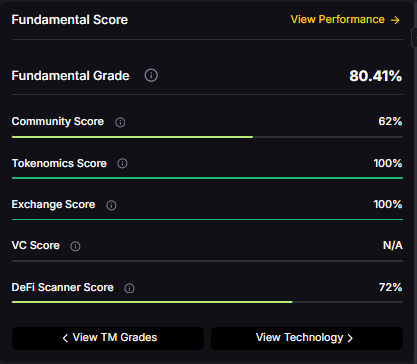
Technology Grade: 29.63% (Activity 22%, Repository 70%, Collaboration 48%, Security —, DeFi Scanner 72%).
Can BCH reach $3,000?
Based on the scenarios, BCH could reach $3,000 in the 23T moon case and 31T base case. The 23T tier projects $3,446.53 in the moon case. Not financial advice.
Can BCH 10x from current levels?
At current price of $553.54, a 10x would reach $5,535.40. This falls within the 31T base and moon cases. Bear in mind that 10x returns require substantial market cap expansion. Not financial advice.
Should I buy BCH now or wait?
Timing depends on your risk tolerance and macro outlook. Current price of $553.54 sits below the 8T bear case in our scenarios. Dollar-cost averaging may reduce timing risk. Not financial advice.
Want exposure? Buy BCH on MEXC
Disclosure
Educational purposes only, not financial advice. Crypto is volatile, do your own research and manage risk.
%201.svg)
%201.svg)
Infrastructure protocols become more valuable as the crypto ecosystem scales and relies on robust middleware. Chainlink provides critical oracle infrastructure where proven utility and deep integrations drive long-term value over retail speculation. Increasing institutional adoption raises demand for professional-grade data delivery and security.
Token Metrics projections for LINK below span multiple total market cap scenarios from conservative to aggressive. Each tier assumes different levels of infrastructure demand as crypto evolves from speculative markets to institutional-grade systems. These bands frame LINK's potential outcomes into 2027.

Disclosure
Educational purposes only, not financial advice. Crypto is volatile, do your own research and manage risk.
How to read it: Each band blends cycle analogues and market-cap share math with TA guardrails. Base assumes steady adoption and neutral or positive macro. Moon layers in a liquidity boom. Bear assumes muted flows and tighter liquidity.
TM Agent baseline: Token Metrics lead metric for Chainlink, cashtag $LINK, is a TM Grade of 23.31%, which translates to a Sell, and the trading signal is bearish, indicating short-term downward momentum. This means Token Metrics currently does not endorse $LINK as a long-term buy at current conditions.
Live details: Chainlink Token Details
Affiliate Disclosure: We may earn a commission from qualifying purchases made via this link, at no extra cost to you.
Token Metrics scenarios span four market cap tiers, each representing different levels of crypto market maturity and liquidity:
8T: At an 8 trillion dollar total crypto market cap, LINK projects to $26.10 in bear conditions, $30.65 in the base case, and $35.20 in bullish scenarios.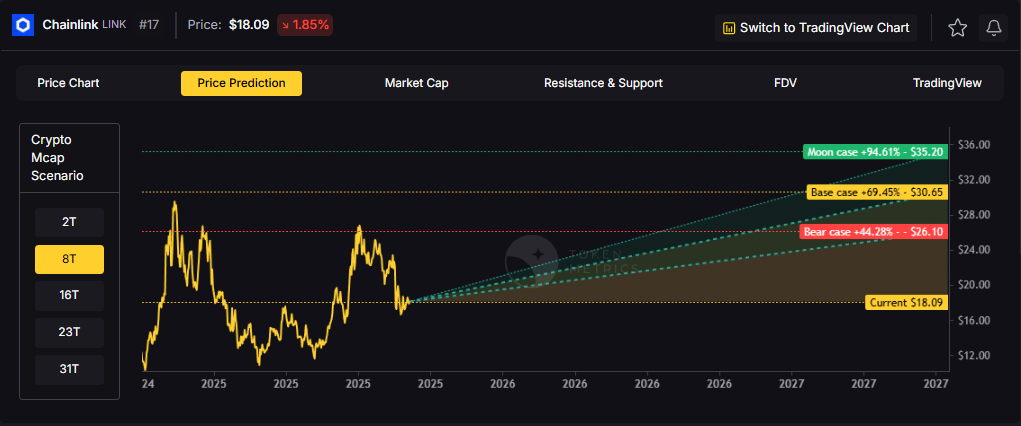
16T: Doubling the market to 16 trillion expands the range to $42.64 (bear), $56.29 (base), and $69.95 (moon).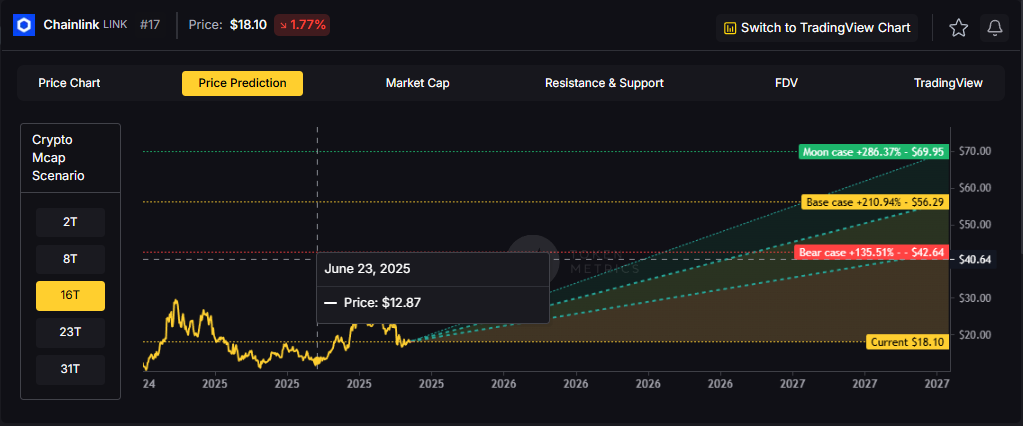
23T: At 23 trillion, the scenarios show $59.18, $81.94, and $104.70 respectively.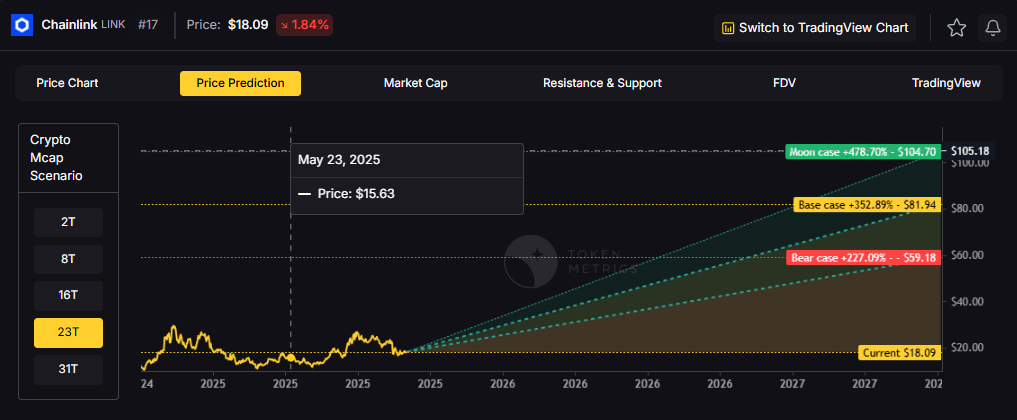
31T: In the maximum liquidity scenario of 31 trillion, LINK could reach $75.71 (bear), $107.58 (base), or $139.44 (moon).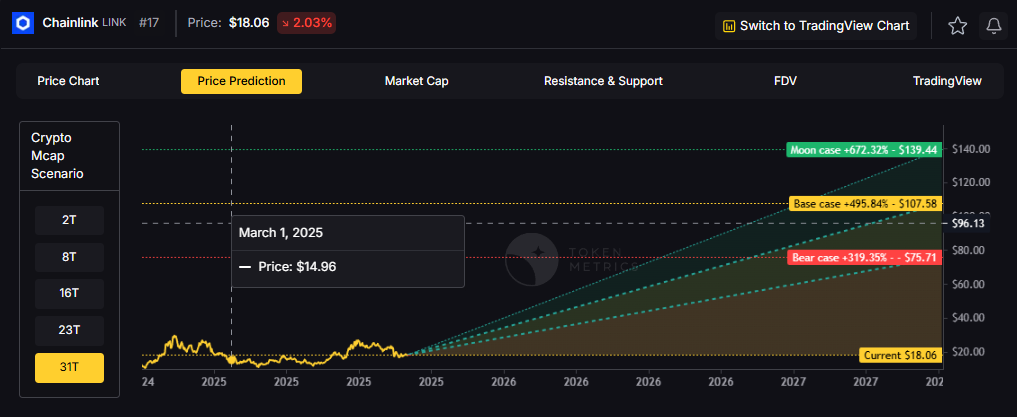
Chainlink represents one opportunity among hundreds in crypto markets. Token Metrics Indices bundle LINK with top one hundred assets for systematic exposure to the strongest projects. Single tokens face idiosyncratic risks that diversified baskets mitigate.
Historical index performance demonstrates the value of systematic diversification versus concentrated positions.
Chainlink is a decentralized oracle network that connects smart contracts to real-world data and systems. It enables secure retrieval and verification of off-chain information, supports computation, and integrates across multiple blockchains. As adoption grows, Chainlink serves as critical infrastructure for reliable data feeds and automation.
The LINK token is used to pay node operators and secure the network’s services. Common use cases include DeFi price feeds, insurance, and enterprise integrations, with CCIP extending cross-chain messaging and token transfers.
Vision: Chainlink aims to create a decentralized, secure, and reliable network for connecting smart contracts with real-world data and systems. Its vision is to become the standard for how blockchains interact with external environments, enabling trust-minimized automation across industries.
Problem: Smart contracts cannot natively access data outside their blockchain, limiting their functionality. Relying on centralized oracles introduces single points of failure and undermines the security and decentralization of blockchain applications. This creates a critical need for a trustless, tamper-proof way to bring real-world information onto blockchains.
Solution: Chainlink solves this by operating a decentralized network of node operators that fetch, aggregate, and deliver data from off-chain sources to smart contracts. It uses cryptographic proofs, reputation systems, and economic incentives to ensure data integrity. The network supports various data types and computation tasks, allowing developers to build complex, data-driven decentralized applications.
Market Analysis: Chainlink is a market leader in the oracle space and a key infrastructure component in the broader blockchain ecosystem, particularly within Ethereum and other smart contract platforms. It faces competition from emerging oracle networks like Band Protocol and API3, but maintains a strong first-mover advantage and widespread integration across DeFi, NFTs, and enterprise blockchain solutions. Adoption is driven by developer activity, partnerships with major blockchain projects, and demand for secure data feeds. Key risks include technological shifts, regulatory scrutiny on data providers, and execution challenges in scaling decentralized oracle networks. As smart contract usage grows, so does the potential for oracle services, positioning Chainlink at the center of a critical niche, though its success depends on maintaining security and decentralization over time.
Fundamental Grade: 74.58% (Community 81%, Tokenomics 100%, Exchange 100%, VC —, DeFi Scanner 17%).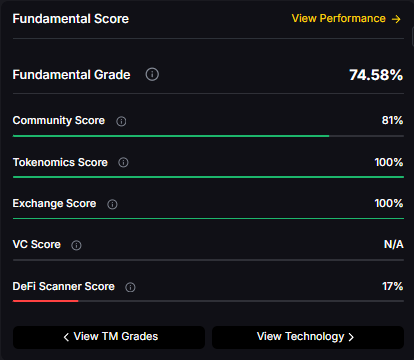
Technology Grade: 88.50% (Activity 81%, Repository 72%, Collaboration 100%, Security 86%, DeFi Scanner 17%).
Can LINK reach $100?
Yes. Based on the scenarios, LINK could reach $100+ in the 23T moon case. The 23T tier projects $104.70 in the moon case. Not financial advice.
What price could LINK reach in the moon case?
Moon case projections range from $35.20 at 8T to $139.44 at 31T. These scenarios assume maximum liquidity expansion and strong Chainlink adoption. Not financial advice.
Should I buy LINK now or wait?
Timing depends on risk tolerance and macro outlook. Current price of $18.09 sits below the 8T bear case in the scenarios. Dollar-cost averaging may reduce timing risk. Not financial advice.
Track live grades and signals: Token Details
Want exposure? Buy LINK on MEXC
Disclosure
Educational purposes only, not financial advice. Crypto is volatile, do your own research and manage risk.
Discover the full potential of your crypto research and portfolio management with Token Metrics. Our ratings combine AI-driven analytics, on-chain data, and decades of investing expertise—giving you the edge to navigate fast-changing markets. Try our platform to access scenario-based price targets, token grades, indices, and more for institutional and individual investors. Token Metrics is your research partner through every crypto market cycle.
%201.svg)
%201.svg)
The crypto market is tilting bullish into 2026 as liquidity, infrastructure, and participation improve across the board. Clearer rules and standards are reshaping the classic four-year cycle, flows can arrive earlier, and strength can persist longer than in prior expansions.
Institutional access is widening through ETFs and custody, while L2 scaling and real-world integrations help sustain on‑chain activity. This healthier backdrop frames our scenario work for HYPE. The ranges below reflect different total crypto market sizes and the share Hyperliquid could capture under each regime.
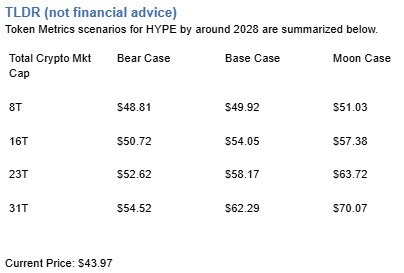
Disclosure
Educational purposes only, not financial advice. Crypto is volatile, do your own research and manage risk.
How to read it: Each band blends cycle analogues and market-cap share math with TA guardrails. Base assumes steady adoption and neutral or positive macro. Moon layers in a liquidity boom. Bear assumes muted flows and tighter liquidity.
TM Agent baseline: Token Metrics TM Grade is 73.9%, a Buy, and the trading signal is bearish, indicating short-term downward momentum. This means Token Metrics judges HYPE as fundamentally attractive over the long term, while near-term momentum is negative and may limit rallies.
Live details: Hyperliquid Token Details
Affiliate Disclosure: We may earn a commission from qualifying purchases made via this link, at no extra cost to you.
Scenario Analysis
Token Metrics scenarios span four market cap tiers, each representing different levels of crypto market maturity and liquidity:
8T: At an 8 trillion dollar total crypto market cap, HYPE projects to $48.81 in bear conditions, $49.92 in the base case, and $51.03 in bullish scenarios.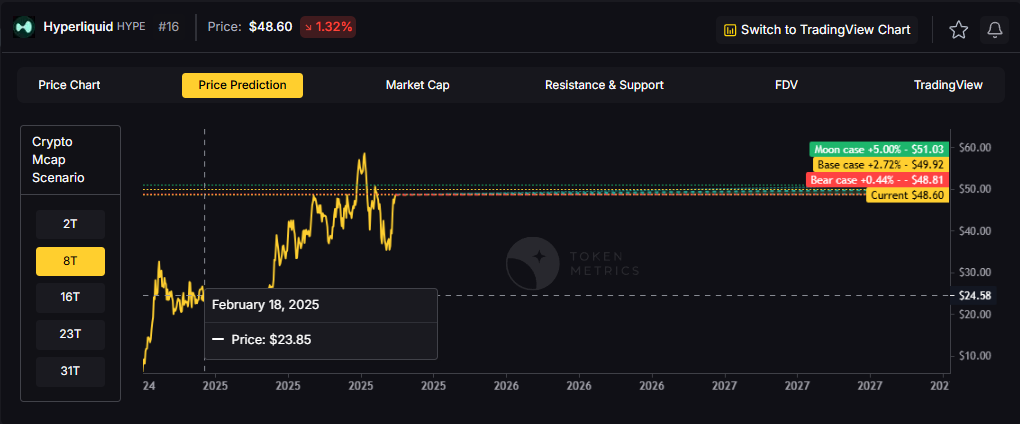
16T: Doubling the market to 16 trillion expands the range to $50.72 (bear), $54.05 (base), and $57.38 (moon).
23T: At 23 trillion, the scenarios show $52.62, $58.17, and $63.72 respectively.
31T: In the maximum liquidity scenario of 31 trillion, HYPE could reach $54.52 (bear), $62.29 (base), or $70.07 (moon).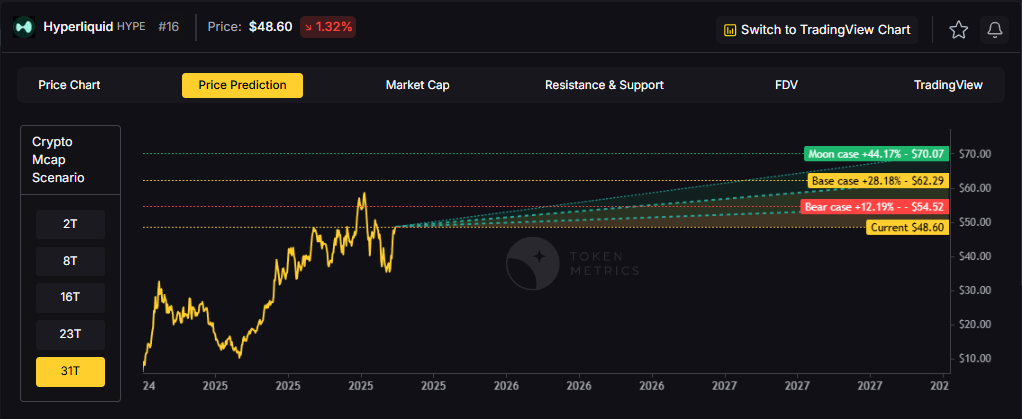
Each tier assumes progressively stronger market conditions, with the base case reflecting steady growth and the moon case requiring sustained bull market dynamics.
Diversification matters. HYPE is compelling, yet concentrated bets can be volatile. Token Metrics Indices hold HYPE alongside the top one hundred tokens for broad exposure to leaders and emerging winners.
Our backtests indicate that owning the full market with diversified indices has historically outperformed both the total market and Bitcoin in many regimes due to diversification and rotation.
Hyperliquid is a decentralized exchange focused on perpetual futures with a high-performance order book architecture. The project emphasizes low-latency trading, risk controls, and capital efficiency aimed at professional and retail derivatives traders. Its token, HYPE, is used for ecosystem incentives and governance-related utilities.
Can HYPE reach $60?
Yes, the 23T and 31T tiers imply ranges above $60 in the Base and Moon bands, though outcomes depend on liquidity and adoption. Not financial advice.
Is HYPE a good long-term investment?
Outcome depends on adoption, liquidity regime, competition, and supply dynamics. Diversify and size positions responsibly.
Disclosure
Educational purposes only, not financial advice. Crypto is volatile, do your own research and manage risk.
Token Metrics delivers AI-based crypto ratings, scenario projections, and portfolio tools so you can make smarter decisions. Discover real-time analytics on Token Metrics.

%201.svg)
%201.svg)
APIs from Google power a huge portion of modern applications, from location-aware mobile apps to automated data workflows in the cloud. Understanding how Google API endpoints, authentication, quotas, and client libraries fit together helps developers build reliable, maintainable integrations that scale. This guide breaks down the most practical aspects of working with Google APIs and highlights research and AI tools that can streamline development.
"Google API" is an umbrella term for a wide range of services offered by Google, including but not limited to Google Cloud APIs (Compute, Storage, BigQuery), Maps and Places, OAuth 2.0 identity, Drive, Sheets, and machine learning APIs like Vision and Translation. Each service exposes RESTful endpoints and often provides SDKs in multiple languages (Node.js, Python, Java, Go, and more).
Key dimensions to evaluate when selecting a Google API:
Popular categories and what developers commonly use them for:
Choosing the right API often starts with mapping product requirements to the available endpoints. For example, if you need user authentication and access to Google Drive files, combine OAuth 2.0 with the Drive API rather than inventing a custom flow.
Follow these practical steps to reduce friction and improve reliability:
These patterns reduce operational surprises and make integrations more maintainable over time.
Security and quota constraints often shape architecture decisions:
Secure-by-design implementations and proactive quota management reduce operational risk when moving from prototype to production.
Combining Google APIs with AI tooling unlocks new workflows: use Vision API to extract entities from images, then store structured results in BigQuery for analytics; call Translation or Natural Language for content normalization before indexing. When experimenting with AI-driven pipelines, maintain traceability between raw inputs and transformed outputs to support auditing and debugging.
AI-driven research platforms like Token Metrics can help developers prototype analytics and compare signal sources by aggregating on-chain and market datasets; such tools may inform how you prioritize data ingestion and model inputs when building composite systems that include external data alongside Google APIs.
Build Smarter Crypto Apps & AI Agents with Token Metrics
Token Metrics provides real-time prices, trading signals, and on-chain insights all from one powerful API. Grab a Free API Key
Google APIs are a collection of RESTful services and SDKs that grant programmatic access to Google products and cloud services. They differ in scope and SLAs from third-party APIs by integrating with Google Cloud's IAM, billing, and monitoring ecosystems.
Use OAuth 2.0 for user-level access where users must grant permission. For server-to-server calls, use service accounts with short-lived tokens. API keys are acceptable for public, limited-scope requests like simple Maps access but carry higher security risk if exposed.
Monitor quotas in Google Cloud Console under the "IAM & Admin" and "APIs & Services" sections. If you need more capacity, submit a quota increase request with usage patterns and justification; Google evaluates requests based on scope and safety.
Cost depends on API type and usage volume. Use the Google Cloud Pricing Calculator for services like BigQuery or Cloud Storage, and review per-request pricing for Maps and Vision APIs. Track costs via billing reports and set alerts to avoid surprises.
Client libraries are not strictly necessary, but they simplify authentication flows, retries, and response parsing. If you need maximum control or a minimal runtime, you can call REST endpoints directly with standard HTTP libraries.
This article is educational and technical in nature. It does not provide financial, legal, or investment advice. Evaluate APIs and third-party services against your own technical, security, and compliance requirements before use.

%201.svg)
%201.svg)
APIs are the connective tissue of modern software. As organizations expose more endpoints to partners, internal teams and third-party developers, effective api management becomes a competitive and operational imperative. This article breaks down practical frameworks, governance guardrails, and monitoring strategies that help teams scale APIs securely and reliably without sacrificing developer velocity.
API management is the set of practices, tools and processes that enable teams to design, publish, secure, monitor and monetize application programming interfaces. At its core it addresses three recurring challenges: consistent access control, predictable performance, and discoverability for developers. Well-managed APIs reduce friction for consumers, decrease operational incidents, and support governance priorities such as compliance and data protection.
Think of api management as a lifecycle discipline: from design and documentation to runtime enforcement and iterative refinement. Organizations that treat APIs as products—measuring adoption, latency, error rates, and business outcomes—are better positioned to scale integrations without accumulating technical debt.
Security and governance are non-negotiable for production APIs. Implement a layered approach:
Combining automated policy enforcement at an API gateway with a governance framework (ownerable APIs, review gates, and versioning rules) ensures changes are controlled without slowing legitimate feature delivery.
Developer experience (DX) determines adoption. Treat APIs as products by providing clear documentation, SDKs and a self-service developer portal. Key practices include:
Metrics to track DX include signups, first successful call time, and repeat usage per key. These are leading indicators of whether an API is fulfilling its product intent.
Operational visibility is essential for api management. Implement monitoring at multiple layers—gateway, service, and database—to triangulate causes when issues occur. Core telemetry includes:
Observability practices—distributed tracing, structured logs, and context propagation—help teams move from alert fatigue to actionable incident response. Build runbooks that map common alerts to remediation steps and owners.
Adopt an incremental roadmap rather than a big-bang rollout. A pragmatic sequence looks like:
Choose tools that match team maturity: managed API platforms accelerate setup for companies lacking infra resources, while open-source gateways provide control for those with specialized needs. Evaluate vendors on extensibility, observability integrations, and policy-as-code support to avoid lock-in.
Build Smarter Crypto Apps & AI Agents with Token Metrics
Token Metrics provides real-time prices, trading signals, and on-chain insights all from one powerful API. Grab a Free API Key
API management encompasses the processes and tools required to publish, secure, monitor, and monetize APIs. It matters because it enables predictable, governed access to services while maintaining developer productivity and operational reliability.
Common components include an API gateway (auth, routing, rate limiting), developer portal (docs, keys), analytics and monitoring systems (metrics, traces), and lifecycle tooling (design, versioning, CI/CD integrations).
Implement defense-in-depth: centralized authentication, token validation, input schema checks, rate limits, and continuous auditing. Shift security left by validating contracts and scanning specs before deployment.
Track latency percentiles, error rates, traffic patterns, and consumer-specific usage. Pair operational metrics with business KPIs (e.g., API-driven signups) to prioritize work that affects outcomes.
Use explicit versioning, deprecation windows, and dual-running strategies where consumers migrate incrementally. Communicate changes via the developer portal and automated notifications tied to API keys.
Introduce a gateway early when multiple consumers, partners, or internal teams rely on APIs. A gateway centralizes cross-cutting concerns and reduces duplicated security and routing logic.
This article is for educational and informational purposes only. It provides neutral, analytical information about api management practices and tools and does not constitute professional or investment advice.

%201.svg)
%201.svg)
APIs are the connective tissue of modern software: they expose functionality, move data, and enable integrations across services, devices, and platforms. A well-designed web API shapes developer experience, system resilience, and operational cost. This article breaks down core concepts, common architectures, security and observability patterns, and practical steps to build and maintain reliable web APIs without assuming a specific platform or vendor.
A web API (Application Programming Interface) is an HTTP-accessible interface that lets clients interact with server-side functionality. APIs can return JSON, XML, or other formats and typically define a contract of endpoints, parameters, authentication requirements, and expected responses. They matter because they enable modularity: front-ends, mobile apps, third-party integrations, and automation tools can all reuse the same backend logic.
When evaluating or designing an API, consider the consumer experience: predictable endpoints, clear error messages, consistent versioning, and comprehensive documentation reduce onboarding friction for integrators. Think of an API as a public product: its usability directly impacts adoption and maintenance burden.
There are several architectural approaches to web APIs. RESTful (resource-based) design emphasizes nouns and predictable HTTP verbs. GraphQL centralizes query flexibility into a single endpoint and lets clients request only the fields they need. gRPC is used for low-latency, binary RPC between services.
Key design practices:
Choose the pattern that aligns with your performance, flexibility, and developer ergonomics goals, and make that decision explicit in onboarding docs.
Security must be built into an API from day one. Common controls include TLS for transport, OAuth 2.0 / OpenID Connect for delegated authorization, API keys for service-to-service access, and fine-grained scopes for least-privilege access. Input validation, output encoding, and strict CORS policies guard against common injection and cross-origin attacks.
Operational protections such as rate limiting, quotas, and circuit breakers help preserve availability if a client misbehaves or a downstream dependency degrades. Design your error responses to be informative to developers but avoid leaking internal implementation details. Centralized authentication and centralized secrets management (vaults, KMS) reduce duplication and surface area for compromise.
Performance considerations span latency, throughput, and resource efficiency. Use caching (HTTP cache headers, CDN, or in-memory caches) to reduce load on origin services. Employ pagination, partial responses, and batch endpoints to avoid overfetching. Instrumentation is essential: traces, metrics, and logs help correlate symptoms, identify bottlenecks, and measure SLAs.
Testing should be layered: unit tests for business logic, contract tests against API schemas, integration tests for end-to-end behavior, and load tests that emulate real-world usage. Observability tools and APMs provide continuous insight; AI-driven analytics platforms such as Token Metrics can help surface unusual usage patterns and prioritize performance fixes based on impact.
Build Smarter Crypto Apps & AI Agents with Token Metrics
Token Metrics provides real-time prices, trading signals, and on-chain insights all from one powerful API. Grab a Free API Key
REST exposes multiple endpoints that represent resources and rely on HTTP verbs for operations. It is simple and maps well to HTTP semantics. GraphQL exposes a single endpoint where clients request precisely the fields they need, which reduces overfetching and can simplify mobile consumption. GraphQL adds complexity in query planning and caching; choose based on client needs and team expertise.
Prefer backward-compatible changes over breaking changes. Use semantic versioning for major releases, and consider header-based versioning or URI version prefixes when breaking changes are unavoidable. Maintain deprecation schedules and communicate timelines in documentation and response headers so clients can migrate predictably.
OAuth 2.0 and OpenID Connect are standard for delegated access and single-sign-on. For machine-to-machine communication, use short-lived tokens issued by a trusted authorization server. API keys can be simple to implement but should be scoped, rotated regularly, and never embedded in public clients without additional protections.
Implement synthetic monitoring for critical endpoints, collect real-user metrics (latency percentiles, error rates), and instrument distributed tracing to follow requests across services. Run scheduled contract tests against staging and production-like environments, and correlate incidents with deployment timelines and dependency health.
Make additive, non-breaking changes where possible: add new fields rather than changing existing ones, and preserve default behaviors. Document deprecated fields and provide feature flags to gate new behavior. Maintain versioned client libraries to give consumers time to upgrade.
Disclaimer
This article is educational and technical in nature. It does not provide legal, financial, or investment advice. Implementations should be evaluated with respect to security policies, compliance requirements, and operational constraints specific to your organization.

%201.svg)
%201.svg)
APIs power modern software by exposing discrete access points called endpoints. Whether you re integrating a third-party data feed, building a microservice architecture, or wiring a WebSocket stream, understanding what an api endpoint is and how to design, secure, and monitor one is essential for robust systems.
An api endpoint is a network-accessible URL or address that accepts requests and returns responses according to a protocol (usually HTTP/HTTPS or WebSocket). Conceptually, an endpoint maps a client intent to a server capability: retrieve a resource, submit data, or subscribe to updates. In a RESTful API, endpoints often follow noun-based paths (e.g., /users/123) combined with HTTP verbs (GET, POST, PUT, DELETE) to indicate the operation.
Key technical elements of an endpoint include:
Endpoints can be public (open to third parties) or private (internal to a service mesh). For crypto-focused data integrations, api endpoints may also expose streaming interfaces (WebSockets) or webhook callbacks for asynchronous events. For example, Token Metrics is an example of an analytics provider that exposes APIs for research workflows.
Different application needs favor different endpoint types and protocols:
Choosing a protocol depends on consistency requirements, latency tolerance, and client diversity. Hybrid architectures often combine REST for configuration and GraphQL/WebSocket for dynamic data.
Good endpoint design improves developer experience and system resilience. Follow these practical practices:
API schema tools (OpenAPI/Swagger, AsyncAPI) let you define endpoints, types, and contracts programmatically, enabling automated client generation, testing, and mock servers during development.
Endpoints are primary attack surfaces. Security and observability are critical:
Operational tooling such as API gateways, service meshes, and managed API platforms provide built-in policy enforcement for security and rate limiting, reducing custom code complexity.
Build Smarter Crypto Apps & AI Agents with Token Metrics
Token Metrics provides real-time prices, trading signals, and on-chain insights all from one powerful API. Grab a Free API Key
An API is the overall contract and set of capabilities a service exposes; an api endpoint is a specific network address (URI) where one of those capabilities is accessible. Think of the API as the menu and endpoints as the individual dishes.
Use HTTPS only, require authenticated tokens with appropriate scopes, implement rate limits and IP reputation checks, and validate all input. Employ monitoring to detect anomalous traffic patterns and rotate credentials periodically.
Introduce explicit versioning when you plan to make breaking changes to request/response formats or behavior. Semantic versioning in the path (e.g., /v1/) is common and avoids forcing clients to adapt unexpectedly.
Combine per-key quotas, sliding-window or token-bucket algorithms, and burst allowances. Communicate limits via response headers and provide clear error codes and retry-after values so clients can back off gracefully.
Track request rate (RPS), error rate (4xx/5xx), latency percentiles (p50, p95, p99), and active connections for streaming endpoints. Correlate with upstream/downstream service metrics to identify root causes.
Choose GraphQL when clients require flexible field selection and you want to reduce overfetching. Prefer REST for simple resource CRUD patterns and when caching intermediaries are important. Consider team familiarity and tooling ecosystem as well.
The information in this article is technical and educational in nature. It is not financial, legal, or investment advice. Implementations should be validated in your environment and reviewed for security and compliance obligations specific to your organization.

%201.svg)
%201.svg)
Modern web and mobile apps exchange data constantly. At the center of that exchange is the REST API — a widely adopted architectural style that standardizes how clients and servers communicate over HTTP. Whether you are a developer, product manager, or researcher, understanding what a REST API is and how it works is essential for designing scalable systems and integrating services efficiently.
A REST API (Representational State Transfer Application Programming Interface) is a style for designing networked applications. It defines a set of constraints that, when followed, enable predictable, scalable, and loosely coupled interactions between clients (browsers, mobile apps, services) and servers. REST is not a protocol or standard; it is a set of architectural principles introduced by Roy Fielding in 2000.
Key principles include:
A REST API organizes functionality around resources and uses standard HTTP verbs to manipulate them. Common conventions are:
Responses use HTTP status codes to indicate result state (200 OK, 201 Created, 204 No Content, 400 Bad Request, 401 Unauthorized, 404 Not Found, 500 Internal Server Error). Payloads are typically JSON but can be XML or other formats. Endpoints are structured hierarchically, for example: /api/users to list users, /api/users/123 to operate on user with ID 123.
Designing a robust REST API involves more than choosing verbs and URIs. Adopt patterns that make APIs understandable, maintainable, and secure:
Following these practices improves interoperability and reduces operational risk.
REST APIs are used across web services, microservices, mobile backends, IoT devices, and third-party integrations. Developers commonly use tools and practices to build and validate APIs:
AI-driven platforms and analytics can speed research and debugging by surfacing usage patterns, anomalies, and integration opportunities. For example, Token Metrics can be used to analyze API-driven data feeds and incorporate on-chain signals into application decision layers without manual data wrangling.
Build Smarter Crypto Apps & AI Agents with Token Metrics
Token Metrics provides real-time prices, trading signals, and on-chain insights all from one powerful API. Grab a Free API Key
"REST" refers to the architectural constraints described by Roy Fielding; "RESTful" is a colloquial adjective meaning an API that follows REST principles. Not all APIs labeled RESTful implement every REST constraint strictly.
SOAP is a protocol with rigid standards and built-in operations (often used in enterprise systems). GraphQL exposes a single endpoint and lets clients request precise data shapes. REST uses multiple endpoints and standard HTTP verbs. Each approach has trade-offs in flexibility, caching, and tooling.
Version your API before making breaking changes to request/response formats or behavior that existing clients depend on. Common strategies include URI versioning (e.g., /v1/) or header-based versioning.
No. Security must be designed in: use HTTPS/TLS, authenticate requests, validate input, apply authorization checks, and limit rate to reduce abuse. Treat REST APIs like any other public interface that requires protection.
Use API specifications (OpenAPI) to auto-generate docs and client stubs. Combine manual testing tools like Postman with automated integration and contract tests in CI pipelines to ensure consistent behavior across releases.
REST is request/response oriented and not ideal for continuous real-time streams. For streaming, consider WebSockets, Server-Sent Events (SSE), or specialized protocols; REST can still be used for control operations and fallbacks.
Disclaimer: This article is educational and technical in nature. It does not provide investment or legal advice. The information is intended to explain REST API concepts and best practices, not to recommend specific products or actions.

%201.svg)
%201.svg)
FastAPI has become a go-to framework for teams that need production-ready, high-performance APIs in Python. It combines modern Python features, automatic type validation via pydantic, and ASGI-based async support to deliver low-latency endpoints. This post breaks down pragmatic patterns for building, testing, and scaling FastAPI services, with concrete guidance on performance tuning, deployment choices, and observability so you can design robust APIs for real-world workloads.
FastAPI is an ASGI framework that emphasizes developer experience and runtime speed. It generates OpenAPI docs automatically, enforces request/response typing, and integrates cleanly with async workflows. Compare FastAPI to traditional WSGI stacks (Flask, Django sync endpoints): FastAPI excels when concurrency and I/O-bound tasks dominate, and when you want built-in validation and schema-driven design.
Use-case scenarios where FastAPI shines:
FastAPI leverages async/await to let a single worker handle many concurrent requests when operations are I/O-bound. Key principles:
Performance tuning checklist:
FastAPI's dependency injection and pydantic models enable clear separation of concerns. Recommended practices:
Scenario analysis: for CPU-bound workloads (e.g., heavy data processing), prefer external workers or serverless functions. For high-concurrency I/O-bound workloads, carefully tuned async endpoints perform best.
Deploying FastAPI requires choices around containers, orchestration, and observability:
CI/CD tips: include a test matrix for schema validation, contract tests against OpenAPI, and canary deploys for backward-incompatible changes.
Build Smarter Crypto Apps & AI Agents with Token Metrics
Token Metrics provides real-time prices, trading signals, and on-chain insights all from one powerful API. Grab a Free API Key
FastAPI is a modern, ASGI-based Python framework focused on speed and developer productivity. It differs from traditional frameworks by using type hints for validation, supporting async endpoints natively, and automatically generating OpenAPI documentation.
Prefer async endpoints for I/O-bound operations like network calls or async DB drivers. If your code is CPU-bound, spawning background workers or using synchronous workers with more processes may be better to avoid blocking the event loop.
There is no one-size-fits-all. Start with CPU core count as a baseline and adjust based on latency and throughput measurements. For async I/O-bound workloads, fewer workers with higher concurrency can be more efficient; for blocking workloads, increase worker count or externalize tasks.
Enforce strong input validation with pydantic, use HTTPS, validate and sanitize user data, implement authentication and authorization (OAuth2, JWT), and apply rate limiting and request size limits at the gateway.
Use TestClient from FastAPI for unit and integration tests, mock external dependencies, write contract tests against OpenAPI schemas, and include load tests in CI to catch performance regressions early.
This article is for educational purposes only. It provides technical and operational guidance for building APIs with FastAPI and does not constitute professional or financial advice.

%201.svg)
%201.svg)
APIs are the connective tissue of modern software. Testing them thoroughly prevents regressions, ensures predictable behavior, and protects downstream systems. This guide breaks API testing into practical steps, frameworks, and tool recommendations so engineers can build resilient interfaces and integrate them into automated delivery pipelines.
API testing verifies that application programming interfaces behave according to specification: returning correct data, enforcing authentication and authorization, handling errors, and performing within expected limits. Unlike UI testing, API tests focus on business logic, data contracts, and integration between systems rather than presentation. Well-designed API tests are fast, deterministic, and suitable for automation, enabling rapid feedback in development workflows.
Effective strategies balance scope, speed, and confidence. A common model is the testing pyramid: many fast unit tests, a moderate number of integration and contract tests, and fewer end-to-end or performance tests. Core elements of a robust strategy include:
Tooling choices depend on protocols (REST, GraphQL, gRPC) and language ecosystems. Common tools and patterns include:
Automation should be baked into CI/CD pipelines: run unit and contract tests on pull requests, integration tests on feature branches or merged branches, and schedule performance/security suites on staging environments. Observability during test runs—collecting metrics, logs, and traces—helps diagnose flakiness and resource contention faster.
AI-driven analysis can accelerate test coverage and anomaly detection by suggesting high-value test cases and highlighting unusual response patterns. For teams that integrate external data feeds into their systems, services that expose robust, real-time APIs and analytics can be incorporated into test scenarios to validate third-party integrations under realistic conditions. For example, Token Metrics offers datasets and signals that can be used to simulate realistic inputs or verify integrations with external data providers.
Build Smarter Crypto Apps & AI Agents with Token Metrics
Token Metrics provides real-time prices, trading signals, and on-chain insights all from one powerful API. Grab a Free API Key
Unit tests isolate individual functions or routes using mocks and focus on internal logic. Integration tests exercise multiple components together (for example service + database) to validate interaction, data flow, and external dependencies.
Run lightweight load tests during releases and schedule comprehensive performance runs on staging before major releases or after architecture changes. Frequency depends on traffic patterns and how often critical paths change.
AI can suggest test inputs, prioritize test cases by risk, detect anomalies in responses, and assist with test maintenance through pattern recognition. Treat AI as a productivity augmenter that surfaces hypotheses requiring engineering validation.
Contract testing ensures providers and consumers agree on the API contract (schemas, status codes, semantics). It reduces integration regressions by failing early when expectations diverge, enabling safer deployments in distributed systems.
Use deterministic fixtures, isolate test databases, anonymize production data when necessary, seed environments consistently, and prefer schema or contract assertions to validate payload correctness rather than brittle value expectations.
Investigate root causes such as timing, external dependencies, or resource contention. Reduce flakiness by mocking unstable third parties, improving environment stability, adding idempotent retries where appropriate, and capturing diagnostic traces during failures.
This article is educational and technical in nature and does not constitute investment, legal, or regulatory advice. Evaluate tools and data sources independently and test in controlled environments before production use.

%201.svg)
%201.svg)
APIs power modern software by letting systems communicate without exposing internal details. Whether you're building an AI agent, integrating price feeds for analytics, or connecting wallets, understanding the core concept of an "API" — and the practical rules around using one — is essential. This article defines what an API is, explains common types, highlights evaluation criteria, and outlines best practices for secure, maintainable integrations.
API stands for Application Programming Interface. At its simplest, an API is a contract: a set of rules that lets one software component request data or services from another. The contract specifies available endpoints (or methods), required inputs, expected outputs, authentication requirements, and error semantics. APIs abstract implementation details so consumers can depend on a stable surface rather than internal code.
Think of an API as a menu in a restaurant: the menu lists dishes (endpoints), describes ingredients (parameters), and sets expectations for what arrives at the table (responses). Consumers don’t need to know how the kitchen prepares the dishes — only how to place an order.
APIs come in several architectural styles. The three most common today are:
Choosing a style depends on use case: REST for simple, cacheable resources; GraphQL for complex client-driven queries; gRPC/WebSocket for low-latency or streaming scenarios.
Documentation quality often determines integration time and reliability. When evaluating an API, check for:
For crypto and market data APIs, also verify the latency SLAs, the freshness of on‑chain reads, and whether historical data is available in a form suitable for research or model training.
APIs expose surface area; securing that surface is critical. Key practices include:
Security and resilience are especially important in finance and crypto environments where integrity and availability directly affect analytics and automated systems.
APIs are central to AI-driven research and crypto tooling. When integrating APIs into data pipelines or agent workflows, consider these steps:
AI models and agents can benefit from structured, versioned APIs that provide deterministic responses; integrating dataset provenance and schema validation improves repeatability in experiments.
Build Smarter Crypto Apps & AI Agents with Token Metrics
Token Metrics provides real-time prices, trading signals, and on-chain insights all from one powerful API. Grab a Free API Key
An API is an interface that defines how two software systems communicate. It lists available operations, required inputs, and expected outputs so developers can use services without understanding internal implementations.
REST exposes fixed resource endpoints and relies on HTTP semantics. GraphQL exposes a flexible query language letting clients fetch precise fields in one request. REST favors caching and simplicity; GraphQL favors efficiency for complex client queries.
Confirm data freshness, historical coverage, authentication methods, rate limits, and the provider’s documentation. Also verify uptime, SLA terms if relevant, and whether the API provides proof or verifiable on‑chain reads for critical use cases.
Rate limits set a maximum number of requests per time window, often per API key or IP. Providers may return headers indicating remaining quota and reset time; implement exponential backoff and caching to stay within limits.
AI-driven research tools can summarize documentation, detect breaking changes, and suggest integration patterns. For provider-specific signals and token research, platforms like Token Metrics combine multiple data sources and models to support analysis workflows.
This article is educational and informational only. It does not constitute financial, legal, or investment advice. Readers should perform independent research and consult qualified professionals before making decisions related to finances, trading, or technical integrations.

%201.svg)
%201.svg)
Modern distributed systems rely on effective traffic control, security, and observability at the edge. An API gateway centralizes those responsibilities, simplifying client access to microservices and serverless functions. This guide explains what an API gateway does, common architectural patterns, deployment and performance trade-offs, and design best practices for secure, scalable APIs.
An API gateway is a server-side component that sits between clients and backend services. It performs request routing, protocol translation, aggregation, authentication, rate limiting, and metrics collection. Instead of exposing each service directly, teams present a single, consolidated API surface to clients through the gateway. This centralization reduces client complexity, standardizes cross-cutting concerns, and can improve operational control.
Think of an API gateway as a policy and plumbing layer: it enforces API contracts, secures endpoints, and implements traffic shaping while forwarding requests to appropriate services.
API gateways vary in capability but commonly include:
Common patterns include:
Choosing where and how to deploy an API gateway affects performance, resilience, and operational cost. Key models include:
Performance trade-offs to monitor:
Adopt practical rules to keep gateways maintainable and secure:
AI and analytics tools can accelerate gateway design and operating decisions by surfacing traffic patterns, anomaly detection, and vulnerability signals. For example, products that combine real-time telemetry with model-driven insights help prioritize which endpoints need hardened policies.
Build Smarter Crypto Apps & AI Agents with Token Metrics
Token Metrics provides real-time prices, trading signals, and on-chain insights all from one powerful API. Grab a Free API Key
These technologies complement rather than replace each other. The API gateway handles north-south traffic (client to cluster), enforcing authentication and exposing public endpoints. A service mesh focuses on east-west traffic (service-to-service), offering fine-grained routing, mTLS, and telemetry between microservices. Many architectures use a gateway at the edge and a mesh internally for granular control.
A gateway introduces processing overhead for each request, which can increase end-to-end latency. Mitigations include optimizing filters, enabling HTTP/2 multiplexing, using local caches, and scaling gateway instances horizontally.
Not always. Small monoliths or single-service deployments may not require a gateway. For microservices, public APIs, or multi-tenant platforms, a gateway adds value by centralizing cross-cutting concerns and simplifying client integrations.
At minimum, the gateway should enforce TLS, validate authentication tokens, apply rate limits, and perform input validation. Additional controls include IP allowlists, web application firewall (WAF) rules, and integration with identity providers for RBAC.
Yes. Aggregation reduces client round trips by composing responses from multiple backends. Use caching and careful error handling to avoid coupling performance of one service to another.
Use a staging environment to run synthetic loads and functional tests against gateway policies. Store configurations in version control, run CI checks for syntax and policy conflicts, and roll out changes via canary deployments.
Managed gateways reduce operational overhead and provide scalability out of the box, while self-hosted gateways offer deeper customization and potentially lower long-term costs. Choose based on team expertise, compliance needs, and expected traffic patterns.
This article is for educational and technical information only. It does not constitute investment, legal, or professional advice. Readers should perform their own due diligence when selecting and configuring infrastructure components.


 Create Your Free Account
Create Your Free Account9450 SW Gemini Dr
PMB 59348
Beaverton, Oregon 97008-7105 US
.svg)




.png)
Token Metrics Media LLC is a regular publication of information, analysis, and commentary focused especially on blockchain technology and business, cryptocurrency, blockchain-based tokens, market trends, and trading strategies.
Token Metrics Media LLC does not provide individually tailored investment advice and does not take a subscriber’s or anyone’s personal circumstances into consideration when discussing investments; nor is Token Metrics Advisers LLC registered as an investment adviser or broker-dealer in any jurisdiction.
Information contained herein is not an offer or solicitation to buy, hold, or sell any security. The Token Metrics team has advised and invested in many blockchain companies. A complete list of their advisory roles and current holdings can be viewed here: https://tokenmetrics.com/disclosures.html/
Token Metrics Media LLC relies on information from various sources believed to be reliable, including clients and third parties, but cannot guarantee the accuracy and completeness of that information. Additionally, Token Metrics Media LLC does not provide tax advice, and investors are encouraged to consult with their personal tax advisors.
All investing involves risk, including the possible loss of money you invest, and past performance does not guarantee future performance. Ratings and price predictions are provided for informational and illustrative purposes, and may not reflect actual future performance.


